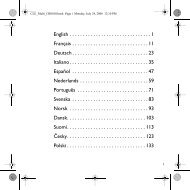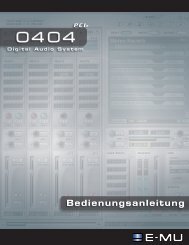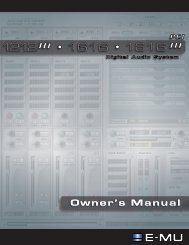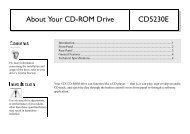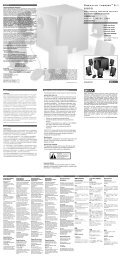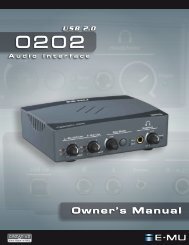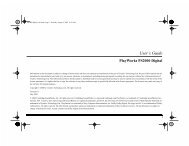You also want an ePaper? Increase the reach of your titles
YUMPU automatically turns print PDFs into web optimized ePapers that Google loves.
4 - The PatchMix DSP Mixer<br />
Mixer Strip Creation<br />
Trim Pot Insert<br />
The Trim Pot Insert allows you to adjust the level of a signal in an insert location. The<br />
trim pot provides up to ±30dB of gain or attenuation and a phase inverter. The trim pot<br />
also has a built-in stereo peak meter after the control.<br />
Gain/Attenuation<br />
Phase Invert<br />
Meters<br />
You might use a trim pot to boost or attenuate a signal send or return from an external<br />
effect, or use it to drive an effect device. Certain effects such as the Compressor,<br />
Distortion, or Auto-Wah are very level dependent and like to see a good strong input<br />
signal. If you are working with a weak signal, you can improve the performance of these<br />
effects inserting a trim pot and boosting the gain.<br />
Trim pots can be used to boost the level of analog line level inputs, but it’s much better<br />
to boost the signal level before the A/D converters in order to get maximum resolution<br />
and signal-to-noise ratio.<br />
The phase invert switch inverts the polarity of the signal. It is generally used to correct<br />
for mics that are wired backwards.<br />
Test Tone/Signal Generator Insert<br />
The test tone/signal generator insert is a handy troubleshooting aid which outputs a<br />
calibrated sine wave, white noise or pink noise. This tool, in combination with an insert<br />
meter, allows you to accurately measure the signal gain or attenuation of an internal or<br />
external device. The test tone can also be quite handy for tuning up musical instruments.<br />
The sine wave oscillator frequency is variable from 20Hz-20kHz. The level is variable<br />
from off to +30dB.<br />
White noise is a mixture of all frequencies in the audio spectrum at the same average<br />
level (analogous to white light in the visible spectrum).<br />
Pink noise provides equal power distribution per octave. (White noise has more power<br />
in the higher octaves.) Pink noise and white noise are useful as wideband sound<br />
sources.<br />
f Musical Note Freq.<br />
A = 440 Hz<br />
B = 493.88 Hz<br />
C = 523.25 Hz<br />
D = 587.33 Hz<br />
E = 659.26 Hz<br />
F = 698.46 Hz<br />
G = 783.99 Hz<br />
22 <strong>Creative</strong> Professional




